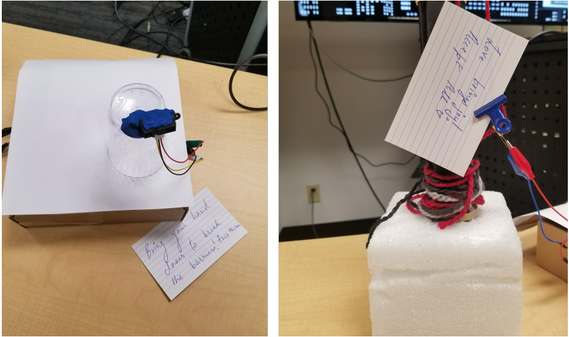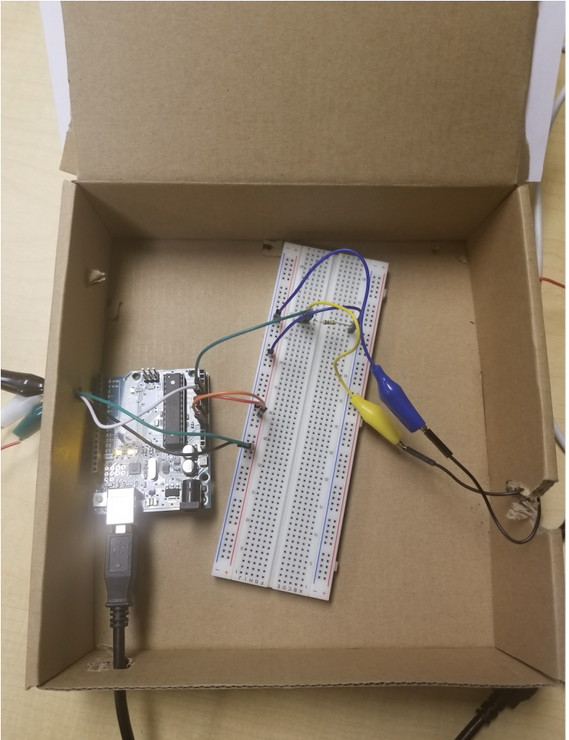Physical Computing | Interactive Art Installation: 'Drowning the Hate Speech'
Team Member: Anmol Anubhai
My Role: Conducting Secondary Research, Prototyping, Arduino Coding, Designing Transitions and Visuals using Processing Software.
Mentors: Prof. Jennifer Mankoff & Prof. Jon Froehlich
Course Name: Prototyping Studio
Tools Used: Arduino, Proximity Sensors and Processing Software
Project Duration: Feb 2018
(This project was designed in a week as a part of our Prototyping Studio weekly challenge.)
Background
The goal of this installation is to encourage people to not give in to hate speech.The goal is to inspire people to express their thoughts of peace by pinning them up on the installation and by watching the art transform in response to it. It is important to not ignore this issue but to face it. Thus, this is conveyed metaphorically through the barbed wire turning from red to a glowing light yellow as you approach it (varying image tints and brightness). One can also see their own-selves on the screen (using a video camera when they first begin approaching the art-form). This is again metaphorical for asking people to reflect on their own actions and beliefs. The art installation plays Hitler’s hate speech dialogue in the background initially. As soon as the viewer pins up his peace message on the art form then the audio track changes to a positive track in response which effectively also drowns the hate speech in the background
Design Context
The idea is to change the viewer’s thinking. This is a small prototype. However,I envision something on similar lines to be implemented on wide streets and in memorial gardens. This art is specially designed for the United States Holocaust Memorial Museum.Also, as an addition, the sound should only be made to trigger when the installation senses people within a certain proximity and should automatically turn off otherwise (in order to prevent disturbance).
Atrium: The Atrium shall be big public spaces such as theaters, memorial gardens, museums and wide streets
Expected Users: The goal of this art installation is to interact with the common man and help change the society’s beliefs. It is to inspire him to reflect as well as express thoughts of peace and love
Prototype Design and Use
The prototype uses a tilt ball sensor as well as a motion sensor. The motion sensor detects the proximity of the viewer from the screen. It begins by switching on the video camera and shows the user herself on the screen. I use text mirroring technique to have a curtain of ”Walls and Hatred” written over the video of the viewer in white. The motion sensor then detects the viewer approaching the screen and shows a picture of a barbed fence in red. Eventually, as the viewer reaches very close to the screen then the brightness of the barbed fence image is made to vary according to the motion sensor’s readings. The brightness increases as you get closer. This is meant to metaphorically imply that if we face and solve these issues then we eventually might be able to solve them.
Mode 1: [The viewer is far]The video camera is switched on and the screen shows the viewer herself on the screen. There is also a white curtain of text superimposed on this video of the viewer. The text reads ”Walls and Hatred”. The art installation uses this metaphor to encourage users to reflect on their own actions and beliefs. Hitler’s hate speech starts in the background.
Mode 2: [The viewer approaches the screen] The motion sensor senses the user and displays an image of a barbed fence with a red tint. The art installation uses this metaphor to help viewers understand how hatred only seems to result into loss of life and sadness. Hitler’s hate speech continues in the background.
Mode 3: [The viewer is very close to the screen] The motion sensor detects the viewer being close. It changes the brightness of the barbed fence art according to the viewer’s proximity. Thus, this metaphor is used to help explain to viewers that it is important to be able to face this issue in order to solve it (remove the barbed fence by lighting it up).
Mode 4: [The viewer pins up a message of peace] The tilt ball sensor connected to the paper pin is switched on and the screen changes to show an image of diverse hands holding the globe. The positive track starts playing in response and starts drowning Hitler’s hate speech. The metaphor here is that we all can spread messages of peace and love in order to drown all forms of hatred.
Reflections and Design Process
This art installation was inspired from the movie ”The Boy in the Striped Pyjamas”. It is a movie that talks about how friendship and love can really cut all possible barbed fences (eradicate hatred). The metaphors were designed keeping in the mind the goal of helping viewers reflect on personal beliefs and actions.The video camera was used because I wanted the viewer to get a personalized experience. The text overlay was used in order to lend the art an abstract effect.The barbed fence art changes its tints and brightness according to the viewer’s proximity to the screen. I decided to do this because I again wanted the viewer to meaningfully engage with the installation. The tints and hues of the barbed fence are designed to go from a ’blood-red’ color to a blinding white color. I decided to do this as it would help the users understand the impact that they can have on these barbed fences (hatred). Eventually the positive audio track was designed to drown Hitler’s hate speech as the main purpose of this installation is to inspire people to stand up against hate speech. The design process included first sketching the rough ideas and interaction flow maps on paper. This was followed by several iterations of refining the interactions.
The Art Installation form is kept simple using a white box to concealthe circuit, a thread pole, a motion sensor mounted on a cup which is hiddenbehind the box and the tilt sensor which is concealed by the paper clip


